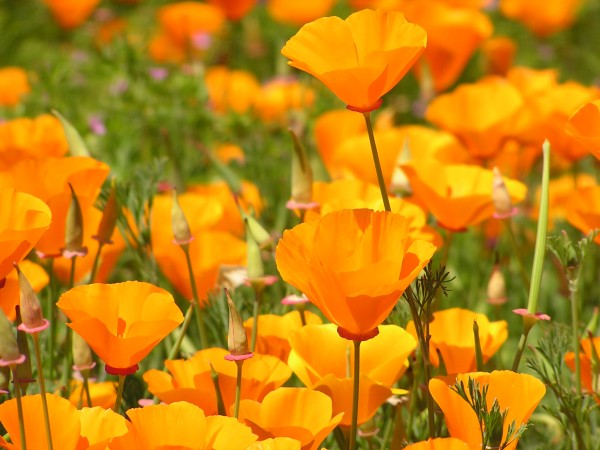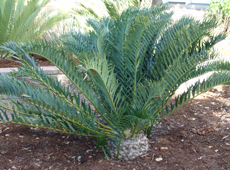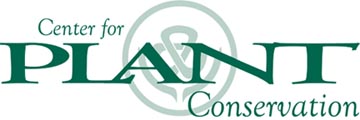Conservation
The UC Botanical Garden comprises one of the most diverse plant collections in the country with over 10,000 taxa. Of these, about 70% are of wild-origin, making it a unique collection for research. In this global collection, there are currently 2,000 rare or endangered taxa, represented by 2,203 accessions (there are multiples of several of the taxa). These can be made available for conservation projects. The major focus of our conservation efforts is on the native California flora, especially in the San Francisco Bay Area.
UCBG Projects
Projects with California Natives:

Eschscholzia californica
For California native plants, the Garden has about 1,600 taxa, representing about 28% of the native flora; it is the largest collection of native California flora in the country. In this collection, there are 208 taxa (297 accessions) of rare or endangered plants as designated by the California Native Plant Society. These represent 25% of all rare taxa in California. Our efforts on seed storage and propagation focus on local threatened or endangered species, with the goal of preserving and providing material suitable for reintroduction. The now virtually extinct Baker’s Larkspur, Delphinium bakeri, known from only a single Marin locality, features prominently in these efforts.
We work in partnership with the national Center for Plant Conservation, California Department of Fish & Game, California State Parks, the National Park Service, US Fish & Wildlife Service, US Bureau of Land Management, the California Native Plant Society, and others.
The Garden is a member of Botanic Gardens Conservation International http://www.bgci.org.uk/, participating in worldwide efforts to track rare species in cultivation for eventual conservation purposes.
International Projects:
 Plant Rescue Station: The Garden helps the service by accepting plants confiscated due to illegal importation into the United States. These are maintained in the collection indefinitely.
Plant Rescue Station: The Garden helps the service by accepting plants confiscated due to illegal importation into the United States. These are maintained in the collection indefinitely.
The Garden is developing a project in conservation of endangered cycad species in collaboration with partners in South Africa. We will post more information as the project develops.
The UC Botanical Garden comprises one of the most diverse plant collections in the country with about 13,000 taxa. Of these, about 70% are of wild-origin, making it a unique collection for research. In this global collection, there are currently 2,000 rare or endangered taxa, represented by 2,203 accessions (there are multiples of several of the taxa). These can be made available for conservation projects. The major focus of our conservation efforts is on the native California flora, especially in the San Francisco Bay Area.
Center for Plant Conservation
 The Center for Plant Conservation (CPC) is a network of more than 35 leading botanic institutions. Its mission is to conserve and restore the rare plants of the United States. Founded in 1984, the CPC operates the only coordinated national program of off-site (ex situ) conservation of rare plant material. This conservation collection ensures that material is available for restoration and recovery efforts for these species. The CPC also works in research, restoration, technical assistance, education and advocacy through the efforts of the network and the national office.
The Center for Plant Conservation (CPC) is a network of more than 35 leading botanic institutions. Its mission is to conserve and restore the rare plants of the United States. Founded in 1984, the CPC operates the only coordinated national program of off-site (ex situ) conservation of rare plant material. This conservation collection ensures that material is available for restoration and recovery efforts for these species. The CPC also works in research, restoration, technical assistance, education and advocacy through the efforts of the network and the national office.
The Garden joined the network of participating institutions of the CPC in 1987. Garden staff are working with many endangered California species, many of which are included in the CPC’s national collection. Two of these, the Presidio manzanita (Arctostaphylos montana ssp. ravenii) and Baker’s larkspur (Delphinium bakeri), have modest endowment funds. The yellow larkspur (Delphinium luteum), has a partial endowment fund for which contributions would be most welcome.
Our emphasis has been on putting seeds into storage and learning to grow the taxa to reproductive maturity. CPC goals are shifting toward improving genetic representation in seed storage and partnering with pertinent agencies/organizations in attempts at reintroduction and/or supplementation of populations.
The Garden is working on various conservation activities for 15 taxa. Since 2001 we have focused on Baker’s larkspur (Delphinium bakeri), known from a single locality in Marin County, California. This locality has been subjected to roadside mowing, fire, and soil removal, bringing the species to the brink of extinction.
Fortunately for this species, the Garden had been collecting limited numbers of seeds before these catastrophic events. These seeds are being used to establish a population at the garden for seed generation and to supply plants for population introductions.
Funding support for this taxon has been provided in part by the Genetic Resources Conservation Program (UC Davis) and the US Fish & Wildlife Service. Our work is now focused on finding suitable introduction sites and propagating material from seed storage for planting in these sites. Experimental plantings in habitat was done in 2009.
Garden conservation activities on Delphinium luteum (yellow larkspur) were featured in the Endangered Species Bulletin Vol. XXVII, No. 3—July/August, 2002 of the USFWS.
Garden staff assisted in the implementation of federal recovery plans for endangered species by implementing the seed banking component for eight Bay Area serpentine endemics (US Fish & Wildlife Service) and four Gabbro soil endemics in the El Dorado County region (US Bureau of Reclamation).
Large-flowered fiddleneck (Amsinckia grandiflora) bibliography
Five Year Review 2009
Recovery Plan Implementation Status
Carlsen et al CNPS 2009
Critical Habitat Designation
Fire and Dynamics of Granivory on a California Grassland Forb Biodiversity Conservation 2005
Reproductive Ecology and the Persistence of an Endangered Plant Biodiversity Conservation 2002
Reducing Competitive Suppression 2000
Populations of Amsinckia grandiflora 1996
Tales of success and failure 1994
Recovery of An Endangered Plant Conservation Biology 1993
Inching toward recovery 1992
Management of reintroduced and natural populations 1992
Reintroduction of Amsinckia grandiflora to three sites 1991
Reintroduction of Amsinckia grandiflora to Stewartville 1990
Habitat Characterization and Selection of Potential Sites for Establishment of New Populations of Amsinckia grandflora 1998
Nutlet Production and Germination of Amsinckia grandiflora 1988

